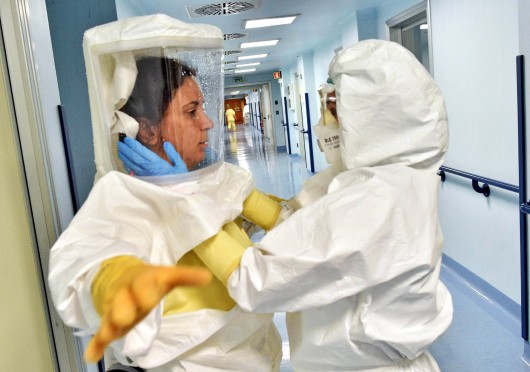
Medical staff wear protective suits as an isolation ward is prepared at Sacco hospital in Milan, Italy, on Oct. 22 in readiness for any potential Ebola outbreak.
Credit: Courtesy of TNS
After multiple cases of the Ebola virus were falsely reported in Central Ohio, some Ohio State students said the hysteria around the virus has grown out of hand. Meanwhile, one psychology professor said it’s up to the government to help control that hysteria.
The best solution to the nervousness would be careful and honest government communication that could build public confidence, said Ellen Peters, professor of psychology and director of the Behavioral Decision Making Initiative at OSU.
“Public confidence in the ability of the government and medical personnel to contain the virus is critical,” she said in an email. “And that confidence can be eroded by the appearance of new cases or through poor communication to the public.”
Public trust is hard to gain but easy to lose, Peters said.
Just recently, multiple media sources reported that a Columbus woman called 911, claiming her sister exhibited signs of the Ebola virus. She told the dispatcher that her sister had recently returned from Africa.
It was a hoax.
The incident, however, was not the only false report in the Columbus area, said Jose Rodriguez, a spokesman from Columbus Public Health.
“We’ve had more than a dozen cases — potential cases,” he said.
Each case that Columbus Public Health has investigated has turned out to be a false alarm, he said.
Still, Peters said it’s important to understand the public’s reaction to the Ebola virus.
“The reasons for its attention-grabbing power are rooted in how humans comprehend risk,” she said.
There are two different “modes” of thought, she said. First there is the deliberate mode — rational, logical, it follows the rules of probability.
“If we used only deliberation, we might conclude that Ebola is so unlikely that it’s not worth thinking about,” Peters said.
However, the second mode — the experiential mode — might tell a different story, she said.
“Processing using this mode is intuitive, fast and based primarily on affective feelings,” Peters said. “Importantly, it’s what has allowed human beings to survive across evolution and it remains the most natural and common way to respond to risk.”
The experiential mode represents risk as a feeling, Peters said. The mode tells a person quickly and spontaneously whether it is “safe to walk down a dark street or to eat some strange-smelling food.”
“Although some view affective responses to risk as irrational, current research says otherwise because these two modes depend on each other for guidance, and both modes are needed for the best decisions,” she said.
The Ebola virus has garnered a varied response since its spread to U.S. soil.
On social media, the Ebola virus remains a hot topic — on Twitter alone, #Ebola has been trending for weeks. Meanwhile, a quick search of the Internet reveals numerous Ebola FAQs, Ebola emergency kits for sale, and just recently, a company has even released an Ebola virus stuffed toy.
The hype surrounding the Ebola virus has lead the Better Business Bureau to warn against scams related to the Ebola virus that have popped up on various fundraising websites.
And some students have taken notice of — and have been frustrated with — the hype.
Karim Ragab, a third-year in English, said he believes the public is over-reacting to the threat of the Ebola virus.
“I think a lot of people here see it as a joke almost,” Ragab said. “Like, it’s not very serious.”
Ragab said he thinks the media are over-exaggerating the impact the Ebola virus is having in the U.S., while at the same time, ignoring the impact it is having in Africa.
So far, 4,922 people have died from the virus worldwide as of Friday, according to the Centers for Disease Control and Prevention website.
Rachel Cannata, a second-year in physics and astronomy, agreed with Ragab.
“I think they’re making a huge deal about it and there’s a lot of panic,” she said.
Cannata said she was not surprised that people are making false reports of Ebola virus symptoms.
“This being flu season, you start to feel unwell, but there’s this fear in the back of your mind like ‘Oh, what if this is Ebola?’” Cannata said. “So it honestly doesn’t surprise me, but I think that plays into this unnatural fear of Ebola being a pandemic in the United States.”
The virus causes symptoms like fever, severe headache and unexplained hemorrhage, or bleeding, according to the CDC. Ebola can only be spread from contact with the blood or bodily fluids of a person or animal who is infected with or has died from Ebola.
Ebola was confirmed in the U.S. on Sept. 30 when a man named Thomas Duncan traveled from Liberia to Dallas. Duncan later died on Oct. 8.
One of his nurses, Amber Joy Vinson, was diagnosed with the virus Oct. 14 after visiting family in the Akron area before she flew from Cleveland back to Texas. Another healthcare worker, Nina Pham, tested positive for Ebola on Oct. 11 in Dallas.
After it was reported that Vinson spent time in Ohio, OSU officials sent out an email Oct. 17 as a precaution and to increase awareness around campus. The email listed ways to prevent the spread of the disease and emphasized how Ebola is spread.
“We can assure you that you are at no risk of contracting Ebola if you have not had direct contact with a person with active symptoms of the disease,” it said.


